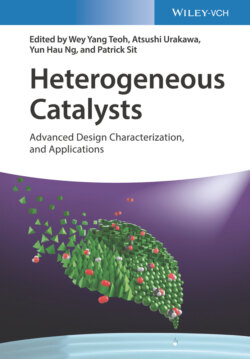Читать книгу Heterogeneous Catalysts - Группа авторов - Страница 17
1.5 Perspectives and Opportunities
ОглавлениеIn the course of 120 years since the discovery of modern heterogeneous catalysis, almost the entire physical length scale of catalyst design with compositions across the periodic table has been explored. From the use of bulk metals in the form of wires and metal strips during the Faraday era to metal nanoparticles and metal clusters and all the way to SACs, the primary objective has always been to identify the most active, selective, and durable catalysts and at the same time economically feasible (not necessarily low cost) and environmentally benign ones. While the classical techniques for catalyst preparation such as impregnation, precipitation, sol–gel, hydro/solvothermal syntheses, and solid‐state sintering continue to be relevant to this day, both industrially and fundamentally, many new syntheses and design strategies have since emerged. They include electrochemical anodization, supramolecular assembly, microwave synthesis, vapor deposition, spray pyrolysis, flame and plasma synthesis, etc. At the same time, design strategies including those with soft and hard templating to induce highly ordered pore structures, engineering of crystal facets and anisotropy (see Chapter 2 on how they can be creatively used to manipulate the target catalytic reactions), ligand‐capping to obtain well‐defined metal clusters, and surface grafting of single‐atom sites were developed to tune the physicochemical characteristics and hence the reactivities of catalysts. It is such a process of continuously pushing the boundaries of catalyst design that led to many new catalytically usable properties, e.g., size and spatial selective pores, localized surface plasmon resonance, size quantization effects, non‐Newtonian metal–support interactions, and low coordination active sites. The ability to uncover and utilize these new catalytic properties for targeted reactions is what constitutes the frontier in the field.
The discovery of new catalysts is often a challenging but highly rewarding task that requires significant amount of trial‐and‐error and optimization (recalling the accomplishments of Alwin Mittasch in discovering the ammonia and methanol synthesis catalysts), even with some high degree of rational design approach. To some extent, it is inevitable because the range of optimum performance is at times quite narrow especially for multicomponent catalysts. Some of these tasks can be alleviated by employing advanced computational screening techniques to streamline the search for targeted catalysts. The coupling of physical screening with machine learning is another highly anticipated technique for the discovery of new and better catalysts. In a way or another, the advancement of computational catalyst design helps to push the boundary of the synthesis techniques in identifying new active sites. This may involve the synthesis of crystal phases or alloys that did not previously exist, new pore topologies, new crystal facets orientation, the engineered spatial deposition of two or more active sites, the creation of particular defects adjacent to the active site, etc.
One may question if it would be possible to move away from the use of precious metals, which, as mentioned, appear to be the favored active sites in many heterogeneous reactions. There is certainly some progress being made in carbon‐based and 2D catalysts, as well as those searching for light transition metal alternatives or the creation of SAC sites of the precious metals. An underlying consideration that often arises is whether the new catalyst solutions are economically feasible, not only from the synthesis point of view but whether the reaction output (or earnings) per cost of catalysts is justifiable to the overall chemical process. This includes the environmental costs in the removal of unwanted byproducts when using less selective catalysts and the disposal (or recyclability) of spent catalysts with toxic elements, e.g., chromium. By any means, a truly modern design of catalysts should as much as possible circumvent the production of byproducts (within the bound of thermodynamics) and the use of toxic elements.
As the value of catalysts changes over time depending on the importance of reactions, one needs to be visionary in terms of the type of catalysts to design and their target functions that cannot yet be achieved with existing catalysts. Among the more recent reactions of interest are those that involve the production of sustainable fuels and food (recalling the Nitrogen Problem in the 20th century), mitigation of global warming and climate change, and the abatement of microplastics and new micropollutants lurking in the environment.
